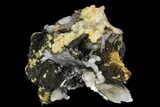This Specimen has been sold.
1.9" Quartz, Aragonite & Epidote Association - Pakistan
This is a cluster of quartz crystals that are peppered with white aragonite aggregations. Epidote can be found along the underside of the specimen mixed in with the matrix. It was collected from the Khuzdar District of Balochistan, Pakistan.
About Quartz
Quartz is the name given to silicon dioxide (SiO2) and is the second most abundant mineral in the Earth's crust. Quartz crystals generally grow in silica-rich environments--usually igneous rocks or hydrothermal environments like geothermal waters--at temperatures between 100°C and 450°C, and usually under very high pressure. In either case, crystals will precipitate as temperatures cool, just as ice gradually forms when water freezes. Quartz veins are formed when open fissures are filled with hot water during the closing stages of mountain formation: these veins can be hundreds of millions of years old.
Quartz is the name given to silicon dioxide (SiO2) and is the second most abundant mineral in the Earth's crust. Quartz crystals generally grow in silica-rich environments--usually igneous rocks or hydrothermal environments like geothermal waters--at temperatures between 100°C and 450°C, and usually under very high pressure. In either case, crystals will precipitate as temperatures cool, just as ice gradually forms when water freezes. Quartz veins are formed when open fissures are filled with hot water during the closing stages of mountain formation: these veins can be hundreds of millions of years old.
Aragonite is one of two common calcium carbonate (CaCO3) minerals: the other is calcite, of which aragonite forms as a pseudomorph. Its crystal lattice differs from calcite, resulting in a different crystal shape. It displays a translucent to white color when pure, and when impure can vary between yellow, green, pink, blue and brown. It typically forms in low-temperature hydrothermal veins, in hot springs, and as precipitates from chemicals in sedimentary rock. It can also form under biological processes: aragonite forms naturally in most mollusk shells, and as the calcareous endoskeleton most corals.
About Epidote
Epidote is a striking and often green mineral known for its complex crystal structure and vitreous luster. It is a calcium aluminum iron silicate that commonly forms in metamorphic rocks, particularly in regions that have undergone low to medium-grade metamorphism. The color of epidote typically ranges from pistachio green to dark green, although it can occasionally appear yellowish-green or even brown due to varying iron content.
Epidote crystals can appear in prismatic, slender forms or as aggregates, and they often exhibit striations along their length. The mineral’s translucent to transparent appearance and high refractive index give it an attractive, glassy shine.
It is commonly associated with minerals such as quartz, feldspar, and garnet, often forming in metamorphic rocks like schist and gneiss. It can also be found in skarn deposits alongside minerals like calcite, diopside, and amphiboles. These associations can provide insights into the geologic history and metamorphic conditions of the region. Epidote is found in locations worldwide, with notable sources including Austria, Norway, Pakistan, and parts of the United States. Collectors prize epidote for its unique green hues and well-formed crystal clusters.
Epidote is a striking and often green mineral known for its complex crystal structure and vitreous luster. It is a calcium aluminum iron silicate that commonly forms in metamorphic rocks, particularly in regions that have undergone low to medium-grade metamorphism. The color of epidote typically ranges from pistachio green to dark green, although it can occasionally appear yellowish-green or even brown due to varying iron content.
Epidote crystals can appear in prismatic, slender forms or as aggregates, and they often exhibit striations along their length. The mineral’s translucent to transparent appearance and high refractive index give it an attractive, glassy shine.
It is commonly associated with minerals such as quartz, feldspar, and garnet, often forming in metamorphic rocks like schist and gneiss. It can also be found in skarn deposits alongside minerals like calcite, diopside, and amphiboles. These associations can provide insights into the geologic history and metamorphic conditions of the region. Epidote is found in locations worldwide, with notable sources including Austria, Norway, Pakistan, and parts of the United States. Collectors prize epidote for its unique green hues and well-formed crystal clusters.
SPECIES
Quartz, Aragonite & Epidote
LOCATION
Khuzdar District, Balochistan, Pakistan
SIZE
1.9" wide
CATEGORY
ITEM
#128726
 Reviews
Reviews













